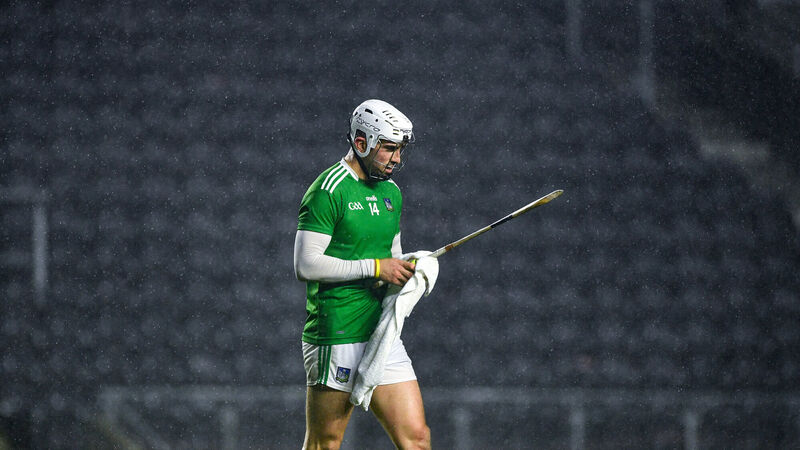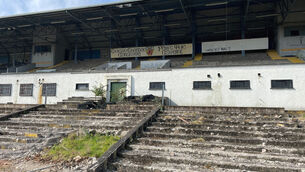Michael Moynihan: Is the hook about to go the way of the overhead pull?

Aaron Gillane of Limerick dries his hurley before scoring his side's second goal from a penalty during the win over Tipp. He showed great improvisation for the first Limerick goal - kicking past Brian Hogan. Picture: Daire Brennan/Sportsfile
Interesting chat last week with someone close to the hurling scene.
(Note to self, I must root that old, possibly apocryphal, guide to puzzling out political sources that circulated a few years back. ‘Well placed’ = Minister, ‘Highly placed’ = senior Minister, ‘Close to’ = anyone from the man in the chipper to the Taoiseach himself).
Anyway, we were chatting about this that and the other, and my pal brought up a passage of play in last weekend’s Limerick-Tipperary game.
Late in the first half Limerick’s Aaron Gillane won the ball very near the Tipp goal and wound up for a shot on goal — Sean O’Brien of Tipp got his hurley in, the ball spun up in the air and Graeme Mulcahy got in to flick it over the bar.
What interested my pal was Gillane’s atypical shot selection: how rare it is now for a forward in hurling to make an error along those lines that allows a defender to get in a hook or a block — and what that means, exactly.
What made Gillane’s abortive try for a goal all the more striking was his improvisation for the first Limerick goal of the evening: having caught the ball in the danger area the traffic was too heavy to wind up and shoot, and Gillane had the presence of mind to kick a daisy-cutter to the corner of the net, wrong-footing Brian Hogan in the Tipp goal.
(Note to Tipperary readers: part of Gillane’s motivation may have been the fact he had Ronan Maher’s hurley rather than his own in his hand. Fact established, but it doesn't invalidate the point.)
Less than a minute earlier Jake Morris had also conjured up a different kind of finish: when Seamus Callanan dinked in that terrific ball to his teammate Limerick defenders flooded back to cut down Morris’s space, but he was able to flick the ball home without winding up like a helicopter to burst the net.
More evidence?
The previous evening TJ Reid, accepted by most as the most consistent and dangerous forward of recent years, got Kilkenny’s second goal against Dublin — again, by adapting his swing.
Having rounded his man Reid converged on goal from an angle but was well aware of the possibility of a hook: again, he batted the ball to the net efficiently, robbing the defender in hot pursuit of any opportunity of a hook or block.
All of which is to point to another marker among the many indications that hurling is a game that continues to grow and develop. The awareness of forwards at all times of the possibility of a hook or block makes it all the more difficult for defenders to get to grips with their men, because forwards are conditioned now not to take those low-percentage pot shots
We used to think of shot selection as an element of common sense: if you were standing on the end line then you didn’t go for a point because the angle didn’t favour you. Now it’s as much about not giving a defender any chance to get in a hook or a block.
That also helps to explain teams’ comfort with moving the ball from side to side and back and forth until a free man pops up with an unobstructed sight of the opposition goal.
We’ve seen great hooks in the past few years — nobody in Kilkenny will ever forget JJ Delaney’s great intervention when Tipp’s Seamus Callanan was bearing down on goal in the 2014 All-Ireland. Tipperary supporters still refer to Padraic Maher’s diving hook against Conor Cooney of Galway in 2016.
In any era managers would be unhappy with forwards allowing themselves to be hooked, but it happens less and less frequently in the modern game. Is the hook the next skill to go the way of overhead pulling?
It turns out there are a couple of places in Cork you can go for a socially distanced/out in the fresh air for coffee, and at one of them during the week a mate of mine raised a very interesting question with me.
(It wasn’t the same man who brought up hooks and blocks in hurling, as cited elsewhere on the page. I do have more than one friend, despite what you may think.)
It was a brisk morning, the old Italian knot on the scarf was needed, and he said, ‘I suppose one thing you don’t have to worry about at the matches in this kind of weather is streakers.’
Given the lack of spectators at games of all kinds now I feel it safe enough to mention this phenomenon without being blamed for a revival, but even the word itself - a streaker! - has such a seventies ring to it.
My immediate association is of watching fuzzy TV action - say, a Five Nations game, in which the two packs, about to scrum down, suddenly stop and look off in a random direction.
Cue hooting from the crowd and some tut-tutting from the commentators about an ‘idiot’, the camera remaining fixed on the players as, out of view, a nude pitch invader was manhandled from the arena, with ‘manhandled’ a term I use advisedly. Ah, great days.
I can’t be 100% sure but I do remember being told that the term originates from a mass nude run at an American university in the seventies: a radio reporter using a payphone (is this the seventies-est column ever?) was describing the event live on air and said the participants were streaking past him.
Hence the term: streaker.
I loaned out a book during the week (to a man who’ll appreciate it) which I mentioned here before, In This Corner by Pete Heller, an all-time favourite read.
Why? Because of passages like this by a boxer called Charley Phil Rosenberg, who was a world champion bantamweight in the twenties.
"Do you know what drying out is? That’s just no liquid but a cup of tea, two cups of tea, in a day. No water or nothing. And when your insides are dried out that’s why I quit, because I’d have two cups of water and I’d gain 10 pounds. I used to get up in the middle of the night and cry. I got up many a night and cried. Not pain. Thirst. You’re in greater shape than any human being and you’re mean. You hate the whole world."
No more loans on offer after this one, though.
Brace yourself for a whole lot of information on the new President of the US, Joe Biden, from his Mayo roots onwards (and outwards).
He has broader tastes in sport than his predecessor, having played American football to a good standard with his high school, which recorded an unbeaten season in 1960 when he starred as a wide receiver. You may find it significant, however, that he stays in touch with many of the other players on that team, attending reunions when his schedule allows. Some of the players living near Biden’s home place in Delaware often get together on a more regular basis for lunch: Biden has popped up there occasionally also, discreetly covering everyone’s lunch bill more than once.
That’s class.








